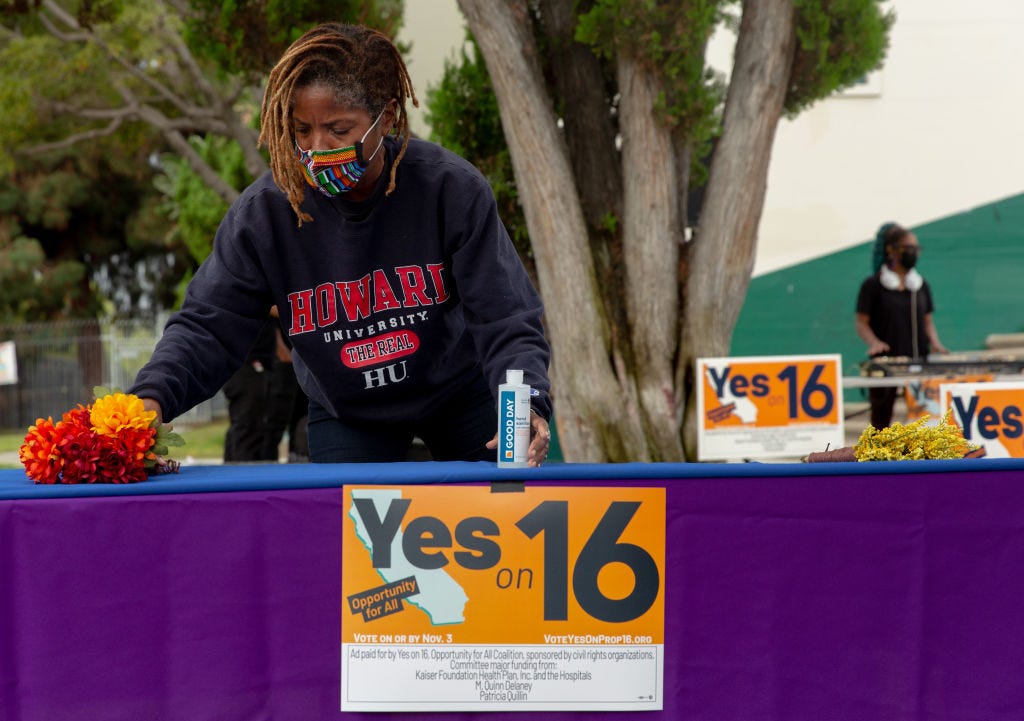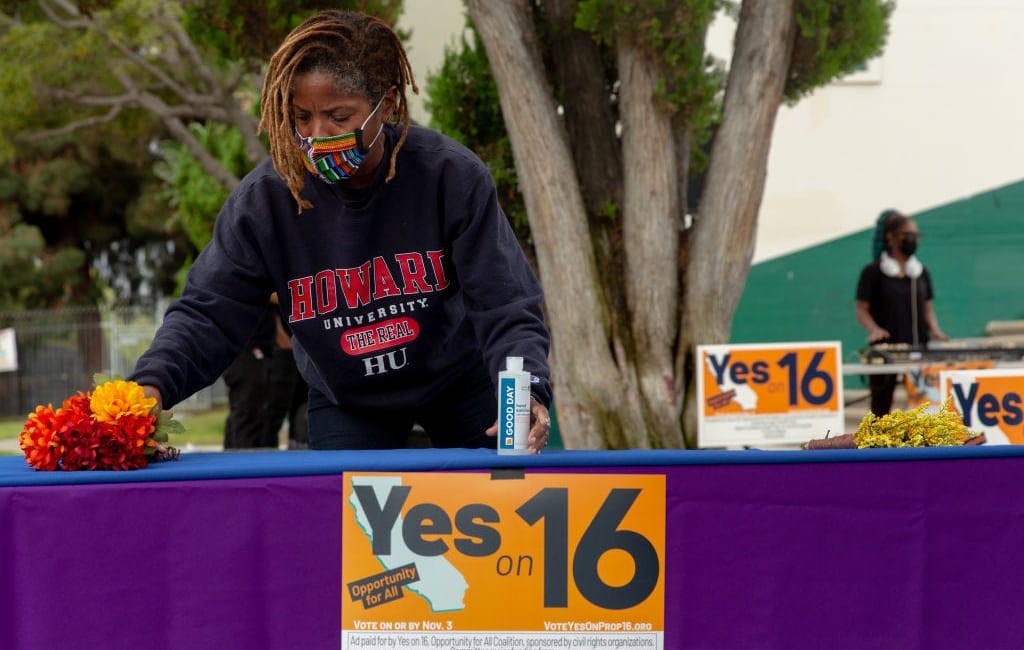
When my eyes popped open at 6:45 a.m. the morning after Election Day, I reached for my phone to check results. While heartening to see that Californians supported a slew of progressive measures like restoring voter rights to parolees, I was extremely disappointed in one outcome: 56% of voters opposed Proposition 16, which would have restored affirmative action in the state.
The point of affirmative action is to increase representation of individuals typically discriminated against or underrepresented in education and public jobs by giving consideration to their gender, race, creed, or nationality. The action stems back to President John F. Kennedy, who first mandated race-based affirmative action on the federal level in the 1960s; gender was added in the 1970s. Since then, eight states including California banned affirmative action, resulting in significant declines in Black, Latinx, Native American, and to a lesser degree Asian American and Pacific Islander (AAPI) student enrollment.
With the increased attention on the Black Lives Matter movement and racial disparities, there seemed to be a logical connection between our current collective awareness and the need to bring affirmative action back to California. Prop 16 — which gained high-profile supporters like Senator Kamala Harris, Governor Gavin Newsom, and Senator Bernie Sanders — would have repealed 1996’s Prop 209, which banned affirmative action in the state. In turn, it would have brought back public institutions’ ability to factor in applicants’ race and gender (among many other factors, including merit) — a step forward once again in addressing systemic racism and sexism.
So why didn’t Californians pass it?
Sign up for The Bold Italic newsletter to get the best of the Bay Area in your inbox every week.
For starters, the language of the measure was confusing. That is true this year and of the 1996 law, too. Back in the ’90s, Prop 209 stated “government and public institutions cannot discriminate against or grant preferential treatment to persons on the basis of race, sex, color, ethnicity, or national origin.” Essentially, proponents of it falsely touted it as a civil rights initiative, when it did the opposite.
The law no longer allowed schools to explicitly recruit Native American students. Black students at California state universities made up 8% of the freshman class in 1997 — now, they make up only 4% even though the number of Black high school graduates has increased. It also ended the collection of procurement data related to gender, ethnicity, and race in parts of California, making it difficult to track trends such as low numbers of women or other underrepresented groups in schools or industries, such as poorer AAPI ethnic groups.
On this year’s ballot, Prop 16’s language stated that it would “repeal Proposition 209 (1996), which stated that the government and public institutions cannot discriminate against or grant preferential treatment to persons on the basis of race, sex, color, ethnicity, or national origin in public employment, public education, and public contracting.” It was the same language from 1996, just with the word “repeal” in front of it. It left voters unclear as to what they were really voting for. Many voiced support once they understood that it was about reinstating affirmative action. Though it wasn’t enough.
Another reason it didn’t pass, of course, is that some in overrepresented (a loaded term in itself) groups feared affirmative action would harm them.
I thought about my own Asian American community, which has historically been split on affirmative action, especially when it comes to top college admissions.The fear is that affirmative action would deny more AAPI students admission to prestigious schools in favor of more underrepresented minorities. But there isn’t enough conversation about how affirmative action can benefit AAPIs greatly in community colleges, public employment, and public contracting.
In California, AAPIs are open to the idea. According to an Asian American voter survey, 62% of AAPIs support it. However, a small, vocal minority is against affirmative action, with AAPI groups having spent nearly $1.2 million in opposition to Prop 16 in conjunction with other mostly conservative voters across races, including Prop 209 mastermind, former UC Regent, and Black conservative Ward Connerly.
Personally, I’ve always been pro-affirmative action, and my family has been involved in Asian American grassroots organizations, including Chinese for Affirmative Action.
AAPI opponents of affirmative action tend to be newer, well-to-do, mostly Chinese immigrants who are unaware of Civil Rights-era history and have been able to jump to middle class life. Or they came with nothing and bootstrapped their way up. If they could work hard and make it on meritocracy, why couldn’t everyone else?
The bootstrapping sentiment echoes the 1987 Time magazine cover that exuded praise for “Those Asian-American Whiz Kids,” which enforced and spread the model minority myth. It was a damning watershed moment for AAPIs, giving credence to the belief that we were a monolithic group of computer nerds who had made it on our own despite racism, and even gave the illusion of breaking free of it purely through hard work.
Our government inadvertently created the model minority stereotype, with the 1965 Immigration Act that ended up paving the way for skilled migrants — especially in STEM industries — from Asia to come to the U.S. The children of those educated immigrants became the poster children of Asian America, which glossed over other groups such as Southeast Asian refugees. Considering that AAPIs make up both the richest and some of the poorest ethnic groups in America, the lack of data for AAPIs has always been problematic and is often used to paint us in a way that satisfies conservative agendas.
While we ourselves invented “Asian American” from a radical need to unify in the 1960s, our grouping of varying cultures and socioeconomic levels together has also been used to divide communities of color.
The Los Angeles Times articulated the sensitivities and nuances of the Prop 16 controversy among AAPIs well, noting the variations in support among different ethnic groups. Indian Americans, for example, overwhelmingly support affirmative action at 86%. This may stem from seeing or experiencing India’s version of affirmative action, where, lower castes have been granted “reservations” (quotas) in some educational and government institutions since the country’s independence in 1950.
White supremacists like to point to the successful parts of minorities and say society doesn’t need affirmative action or other policies to address systemic racism — “look, you can just work hard and be successful!” But then Black and Brown groups often point to the AAPI community as buying into the conservative ideology that the American Dream is only achievable via willfully ignorant colorblindness. All of this drives a made-up notion that success means striving for whiteness, which automatically means embracing anti-Blackness. Every group can blame AAPIs, and nothing actually has to change. We get distracted from dismantling the system that pits us against each other.
But if we say that Black Lives Matter, that we’re for equality — we have to be willing to change our systems actively, not passively. That’s where affirmative action comes in. This summer’s social justice actions included supporting Black-owned businesses. But BIPOC and women don’t usually have access to the traditional channels of capital to start businesses or be visible. Prop 16 would have increased the chances of women- and BIPOC-owned businesses to secure public contracts, among other improvements.
Reinstating affirmative action would have been a step in the right direction. It’s messy and imperfect, and I hope for more emphasis on socioeconomic background. But it’s just one part of our evolution. In the journey toward equality — some fights we win and some fights we lose. We lost Prop 16. But the work continues.







